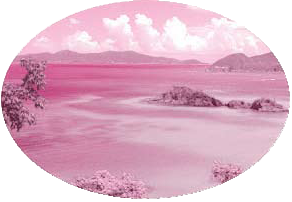




从丹麦手中
|

|
如果你拥有一座热带岛屿,你会把这座岛屿取名为什么?当美国于1917年3月31日正式接管丹麦在西印度群岛上的殖民地时,美国决定将这些岛屿命名为“维京群岛”。美国以2500万美元的代价,从丹麦手中买下这些岛屿。


|
Reading in a single sitting
|
The Virgin Islands(维京群岛)of the United States (commonly called the United States Virgin Islands or U.S.Virgin Islands) are a group of islands in the Caribbean that are an insular area of the United States. The islands are geographically part of the Virgin Islands archipelago and are located in the Leeward Islands of the Lesser Antilles. Formerly the Danish West Indies(丹麦西印度群岛), they were sold to the United States by Denmark in the Treaty of the Danish West Indies of 1916. They are classified by the UN as a Non-Self-Governing Territory(不自治地区), and are currently an organized, unincorporated United States territory.
Initially proposed in 1867, the Virgin Islands were acquired in response to an inflated fear of German hegemony during a tentative period of the First World War.
Denmark, for one, had exhausted itself in war with Germany and the great power of Prussia(普鲁士)on the question of Schleswig-Holstein(石勒苏益格-荷尔斯泰因)beginning in 1848, and began to sell its other possessions in India and the African coast to Britain in the 1850 s, revealing a declining Scandinavian presence in colonial world affairs as the German Empire began an extensive occupation of African land. The question naturally shifted to the probable sale of the West Indian islands, which, though invariably prosperous economically, were administratively unstable. The "precedent" to sell the islands to the United States then came to the Danish West Indies in 1867. The United States had a trading relationship with the free port of the Danish West Indies since the American Revolution. In 1867 the United States looked into buying the islands as a military and navy harbor; as early as 1865 United States Secretary of State William H.Seward approached Danish foreign minister Waldemar Raasloff to negotiate a possible purchase of the islands, but ill health and Lincoln' s assassination temporarily halted conversations. When in 1867 conversations did reach the Danes, progress was aggravated by relations with Prussia and stoppages by the Conservative government.
The Treaty of 1867 finally reached the floor at Copenhagen(哥本哈根)on October 24, which outlined the provisional government in place should the United States complete the purchase. The United States Senate, however, after much delay in pressing for ratification by both parties, finally rejected the treaty in 1870.
The sale of the islands was brought up again on diplomatic levels throughout the 1890 s, when the proposal for the Panama Canal(巴拿马运河)was discussed, and rumors began about the island' s possible transfer to Germany. After the Spanish-American War, which ceded Puerto Rico, Guam and the Philippines to the United States, the question of the sale of the Danish West Indies was brought up again in congressional sessions.

The Treaty of 1902 for the sale of the entire Danish West Indies was approved and ratified in the United States in February and signed by President Theodore Roosevelt in May. Denmark' s lower and upper houses, however, were divided, and a split vote was vetoed against the purchase. This aristocratic stalemate from the Danish Landsting halted the purchase of the islands until 1916, when the United States' military "urgency" was prompted by German naval aggression before the outbreak of World War I.Denmark' s own constrained bursary, under a threatened position from the encroachment of the German Empire in the south, undoubtedly facilitated the purchase.
The official transfer ceremony of the rechristened United States Virgin Islands occurred on March 31, 1917, with the previous register of using the islands primarily as a "military base." A week following the transfer, the United States entered World War I, for which the islands, despite their intent, served no direct purpose. The sale of the islands was, preparedly, retention of diplomatic fears of foreign nations, and one that proved to be unfounded, and the islands remained under military occupation until the 1930 s, gradually assuming their semi-autonomous territorial status in the following decades.
美属维尔京群岛是美国在加勒比海的一个非建制属地(Unincorporated Territory)群岛。该群岛原名为丹麦属西印度群岛,后于1916年被美国从丹麦手中买下并改为现名。
1848年废除奴隶制之后,美国开始与丹麦就购买群岛的事进行谈判。1917年,美国以2500万美元购下群岛。初由美国海军管辖,1931年移交给内政部,由总统任命一文职总督治理群岛。旅游业于1945年开始发展。1954年,维尔京群岛组织法进行了修改,旋即创立了现行的政府结构。1970年,第一个民选总督就职,1976年群岛被授予起草宪法的权利,但需经美国国会和总统的批准。1978年宪法起草完成,但在1979年公民表决中被否决,1981年修改后再次被否决。1960-1975年间,从美国本土、加勒比海东部和波多黎各涌入的大量移民造成了岛民和新移民之间的社会紧张局面。
archipelago 群岛
unincorporated 非建制的
inflated 膨胀的
hegemony 霸权
Scandinavian 斯堪的纳维亚的
assassination 暗杀
aggravate 恶化
outline 概述
ratification 批准
stalemate 僵局
Landsting 上议院(旧时丹麦议会的)
encroachment 侵犯
semi-autonomous 半自治的

|
Key Words in History
|
The Treaty of the Danish West Indies, officially the Convention between the United States and Denmark for cession of the Danish West Indies, was a 1916 treaty transferring sovereignty of the Danish West Indies from Denmark to the United States, which were renamed as the United States Virgin Islands, in exchange for a sum of US$25, 000, 000 in gold.
Famous labor leader David Hamilton Jackson made a visit to Copenhagen in May 1915. He successfully raised awareness of the growing social desperation on the islands and the need for to enter the customs territory of the United States in order for the islands to be able to cope with their economic crisis. The Danish government was convinced that the islands had to be sold for the sake of both the residents and Danish security, and that a transfer would have to be realized before the United States entered the war, so that the transfer would not become a violation of the Danish neutrality.
Each year, on the third Monday in June, the Virgin Islands recognize Organic Act Day, which commemorates the organization of a new government in the U.S.Virgin Islands. The U.S.Congress granted citizenship to Virgin Islanders in 1927 and universal suffrage was given in 1936 to all persons who could read and write English, but the Islanders did not have their own government. On June 22, 1936, President Franklin D.Roosevelt signed the Organic Act law that gave the Virgin Islands their own Constitution. President Dwight D.Eisenhower signed a revised Organic Act on July 22, 1954, unifying the Islands' legislature. A unicameral 15-person legislature serves the Virgin Islands, and congressional legislation gave the Islands a nonvoting representative in Congress. Residents of the islands largely enjoy the same rights as mainlanders, but they cannot vote in presidential elections.
Organic Act Day is observed during Carnival-a month-long celebration in the Virgin Islands that includes parades, fireworks, calypso music and dancing, and more.

|
Background Knowledge
|
最早在维尔京群岛居住的是西波内人、加勒比人和阿拉瓦克人。群岛的名称是1493年克里斯托弗·哥伦布在他的第二次探险过程中,以圣乌尔苏拉及其处女追随者起的。在此后两百年里,西班牙、英国、荷兰、法国和丹麦、挪威等欧洲列强相继占据它。
1672年丹麦西印度公司在圣托马斯岛上设立据点,1694年在圣约翰岛上设立据点。1733年从法国购买了圣克罗伊岛。1754年群岛成为丹麦王家殖民地,被命名为丹麦西印度群岛。在18世纪和19世纪初,通过奴隶的劳动,甘蔗成为群岛经济的主要动力。1848年7月3日,丹麦废除奴隶制。
此后该群岛经济上无法自立,丹麦必须向群岛政府转汇大量金钱。1867年丹麦与美国达成协议,出售圣托马斯岛和圣约翰岛,但是这个交易没有执行。群岛政府试图通过一系列改革复苏群岛的经济,但是没有获得多少成效。1902年,两国又一次协议转售,但是丹麦议会否定了这笔交易。
第一次世界大战的爆发导致改革中止,群岛又一次处于孤立无援的境地。美国担心德国占据维尔京群岛作为其潜艇战基地,因此再次向丹麦政府提出购买的建议,与此同时丹麦政府面临着国内经济沉重的持续萧条,因此在议会中也呈现了同意出售的共识。就这样,经过数月谈判,双方达成协议。
1916年8月双方签署条约,1916年12月丹麦进行全民公投批准了这个决议。1917年1月17日,美国和丹麦交换了各自签署的条约,该条约正式生效。1917年3月31日,美国开始控制美属维尔京群岛。1927年群岛上的居民被授予美国公民权。
水岛是一个位于圣托马斯南的小岛,它本来属美国联邦政府管理,一直到1996年始终没有像美属维尔京群岛的其他岛屿那样被纳入美国领土。1996年,水岛上约20公顷的土地被转给群岛政府管理,其余的82公顷于2005年5月从美国内务部以10美元的价格卖给了群岛政府,这个转售正式标志着该岛剩余部分的主权转变。
目前美属维尔京群岛被列入联合国不自治地区的列表。1993年的全民公投只有31.4%的人参加,因此其结果(维持现状)被视为无效。目前该地区没有进行其他公投的计划。